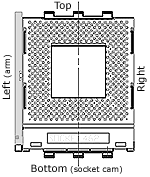MSI KT4 Ultra-FISR KT400 Motherboard Review
 It's nice
to see that MSI continually upgrade their boards to
the latest technological goodness. From our standpoint, we have been
seeing the adoption of new devices and on board features from the days of
the original KT266 chipset. More recently, MSI have adopted bluetooth and the very alluring 8X
AGP.
It's nice
to see that MSI continually upgrade their boards to
the latest technological goodness. From our standpoint, we have been
seeing the adoption of new devices and on board features from the days of
the original KT266 chipset. More recently, MSI have adopted bluetooth and the very alluring 8X
AGP.
I suppose even D-LED counts towards the score card.
This time however, it is the two little black sockets on the MSI
KT4 Ultra-FISR which are revolutionary, and actually really exciting... for
a techie anyway :)
Before we
get into that, you should know that the KT4 Ultra-FISR is based on the
brand new the VIA KT400 chipset. The KT400 chipset supports AthlonXP processors at FSB's
of 100MHz, 133MHz, and the tantalizing 166MHz. Now even with
on board IEEE1394 and bluetooth support, it is really those two small Serial
ATA 150 connectors which manage to draw our undivided attention.
Serial
ATA is the new spec for connecting devices like hard drives, and marks the end
of a long history with IDE. As you will see, Serial ATA cables are
really tiny and operate on a point-to-point topology (the drives
are not yet available so we can't offer any benchmarks at this
time unfortunately). Looking around the cramped PCB on the MSI KT4 Ultra-FISR,
we can say it's easily the most equipped motherboard we've ever tested!
The
KT4 Ultra features; on board 5.1 hardware
based audio, three IEEE 1394 (Firewire
) ports, six USB 2.0 (thanks to the VT8235 southbridge),
a
Gigabit ethernet (10/100/1000!) RJ45 jack, optional
bluetooth capability , two Serial
ATA ports plus one regular Ultra/133 IDE port, three DDR400
compatible DIMM slots, six PCI slots and 8x AGP!
Did MSI miss
anything with this motherboard? No I don't think so!
Everything but the kitchen sink is here, and three expansion brackets round
out the list of included gear. The price range is around the $150US
mark, which is pretty impressive in an of itself.
Overclocking:
MSI motherboards
have always been well rounded with great hardware features and good prices, but
they've usually never really been regarded as supernatural overclockers.
With some mighty impressive overclocking options in the KT4
Ultra BIOS, some hand picked Corsair memory, and some mighty
high hopes, we set forth for a little OC adventure.
Knowing that the Corsair XMS3200 was capable of walking
the 200 MHz waltz, I immediately lowered the multiplier and up'ed the FSB
to 200 MHz. I know I always tell you guys to be patient and go slowly but I
never follow those rules.
At 200 MHz, the system was a no-go
no matter what I tried. A bit disappointed, I reset the CMOS then tried 190 MHz
FSB but still nothing. Finally after tinkering with the board I settled on a
maximum FSB of 185 MHz. Not too shabby, but not the best overclock either.
Hopefully retail boards will overclock better then this beta one.
Around the Socket: Heatsink Clearances
|
pcstats heatsink clearance
measurements |
 |
Top Clearance: |
10mm |
| Bottom (cam) Clearance: |
10mm |
|
| Left Side (arm) Clearance: |
24mm |
| Right Side Clearance |
15mm |
|
| Socket Mounting Holes: |
none |
| Max. Heatsink Base Dimensions (wxh): |
~87x84 mm |
|
 Note: Approx.
measurements are made from the edge of the socket (not the clips) to the
closest obstacle taller than the ZIF socket itself. The socket is 51mm
across, and 62mm from top to
bottom. Note: Approx.
measurements are made from the edge of the socket (not the clips) to the
closest obstacle taller than the ZIF socket itself. The socket is 51mm
across, and 62mm from top to
bottom.
|
Our biggest qualm with the KT4 Ultra is the
absence of the four heatsink mounting holes. Other then that, if one uses a large
clip on heatsink, there is nothing to block your way.

